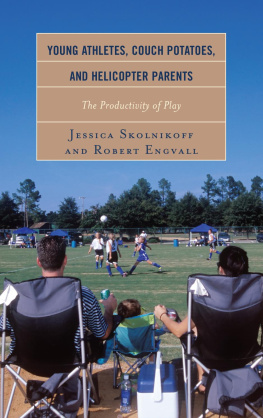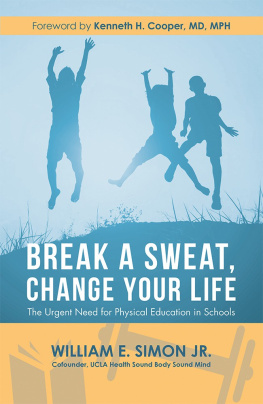Young Athletes,
Couch Potatoes,
and Helicopter Parents
Young Athletes,
Couch Potatoes,
and Helicopter Parents
The Productivity of Play
Jessica Skolnikoff and Robert Engvall
ROWMAN & LITTLEFIELD
Lanham Boulder New York Toronto Plymouth, UK
Published by Rowman & Littlefield
4501 Forbes Boulevard, Suite 200, Lanham, Maryland 20706
www.rowman.com
10 Thornbury Road, Plymouth PL6 7PP, United Kingdom
Copyright 2014 by Rowman & Littlefield
All rights reserved. No part of this book may be reproduced in any form or by any electronic or mechanical means, including information storage and retrieval systems, without written permission from the publisher, except by a reviewer who may quote passages in a review.
British Library Cataloguing in Publication Information Available
Library of Congress Cataloging-in-Publication Data
Skolnikoff, Jessica.
Young athletes, couch potatoes, and helicopter parents : the productivity of play / Jessica Skolnikoff and Robert Engvall.
pages cm
Includes bibliographical references and index.
ISBN 978-1-4422-2979-2 (cloth : alk. paper) -- ISBN 978-1-4422-2980-8 (electronic)
1. Sports for children--Social aspects--United States. 2. Sports for children--United States. 3. Physical education for children--United States. 4. Play--Social aspects--United States. 5. Parent and child--United States. I. Engvall, Robert P. II. Title.
GV709.2.S495 2014
796.083--dc23
2013038147
 TM The paper used in this publication meets the minimum requirements of American National Standard for Information Sciences Permanence of Paper for Printed Library Materials, ANSI/NISO Z39.48-1992.
TM The paper used in this publication meets the minimum requirements of American National Standard for Information Sciences Permanence of Paper for Printed Library Materials, ANSI/NISO Z39.48-1992.
Printed in the United States of America
Acknowledgments
We wrote this book because we thought the stories within and the concepts weve discussed with each other were worth telling others and thus would be worthy of writing about. We, of course, didnt do this alone. We should acknowledge the many contributions made by others, including our express appreciation to the Roger Williams University Foundation to Promote Scholarship and Teaching, which provided us course releases allowing us the time necessary to devote to this project.
We are also grateful to the many friends and colleagues who have listened to a variety of our presentations over the years, most specifically at popular culture/American culture conferences, and who have provided invaluable feedback and encouragement. Much of their feedback and questions provided the foundations for particular chapters within this work. Also, Jessica presented some of her original youth and activities level research at the American Anthropological Association and Society for Applied Anthropology Conference.
Thanks to Christen Karniski of Scarecrow Press for believing that our ideas were worth putting on paper, and to Bridget Fitzpatrick for giving us much-needed editing comments and critiques of our writing, as well as pushing us to consider other ideas as well.
Lastly, and most importantly, this book could not have been written without the contributions of parents, coaches, recreation directors, teachers, administrators, and, most of all, the kids, through their time and willingness to talk to us about their sporting experiences. It is their voices along with ours that we hope come through in this work.
We will forever be indebted to our parents for their support in our own sports endeavors from young children to grown adults and to our immediate families for putting up with us while we wrote this thing! Thank you! We hope that our children have as much fun with sport as we doeven if they choose not to spend valuable time analyzing it so often.
Introduction
This book arose from our common interests in sports and popular culture. We have had numerous discussions over the years ranging from academic debates about the place of sports in our society to informal conversations about our own sports fandom and our own involvement directly and indirectly in sports, both organized and formally and unorganized and informally. How sports affect our day-to-day lives has tended to be, we suppose quite naturally, a day-to-day conversation. From these conversations have developed a series of topics that we believe will be of interest to the reader. Some of these topics have been the basis of presentations weve made and research weve done concerning sports and the relationship between sports and popular culture. Others have merely been fodder for water cooler conversations that weve deemed worthy of not only our further examination but also, we believe, for others to read, and to compare and contrast with their own life experiences.
This isnt intended as a critique of sports or the sporting culture, as those critiques have been done and, in many cases, done well. The overwhelming number of scholarly works within the field of sport criticism have long held sport socially, politically, and culturally suspect, a uniformity that remains apparent today (Rosen 2007, 2). Rosen, himself, is a good source for an analysis of the history or evolution of American attitudes toward competition as seen through the lens of sports. Criticizing much of the excesses that surround sports in our society is relatively easy, as the targets seem to consistently grow larger.
It has often been said that life gets in the way when one makes plans for the future. Writing a book truly exemplifies the truth of that adage. In the throes of writing this book, the marathon bombing occurred in Boston, a city not too far from the campus where we both teach, and where one of us grew up in the suburbs. Both of us had friends in that very race that day, and the horrible juxtaposition of the joy of competition and dedication faced with the horror of terrorism, murder, and mayhem puts sports into context for all of us. The marathon bombing occurred on a Monday, and given the events of that nightmarish week for the city of Boston, numerous sporting events were cancelled or postponed, including games featuring the Celtics, Bruins, and Red Sox. By Saturday, the Red Sox welcomed the fans back to Fenway Park with a celebration of the Boston police and others who worked so hard to respond to the events of the Monday before. Whether or not sports assisted in the healing of the city, is open, we suppose, to interpretation. But we are not the first to suggest that, at a minimum, sports contributed to a return to normalcy. The premise that sports contribute to the quality of our lives, both directly and indirectly, seems almost self-evident. The return to the playing fields in both Major League Baseball and the National Football League several days after September 11, 2001, also served to return a sense of the routine and the comfortable to an unsteady and shaken country. When the Yankees returned to play after 9/11, there were many signs throughout baseball stadiums expressing sentiments like we are all New Yorkers now, suggesting that the collective camaraderie of sports fans does have the potential to bring people together even across deeply partisan rooting lines.
The marathon bombing, like the events of September 11, showed both the relative unimportance of sports in the context of life, and the difference sports make and thereby the importance of sports in our lives. Just as wonderful and traditional celebrations of the sporting life can go horribly awry given the actions of a dangerous few, so too can we recognize the contributions that sports makes in the quality of our individual and collective lives. One didnt have to like baseball to recognize the cathartic nature of what happened at Fenway Park on that Saturday for the city of Boston. A gathering of thirty-five thousand or so people cheering in unison for the city, its first responders, and police force wasnt
Next page








 TM The paper used in this publication meets the minimum requirements of American National Standard for Information Sciences Permanence of Paper for Printed Library Materials, ANSI/NISO Z39.48-1992.
TM The paper used in this publication meets the minimum requirements of American National Standard for Information Sciences Permanence of Paper for Printed Library Materials, ANSI/NISO Z39.48-1992.